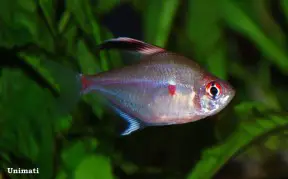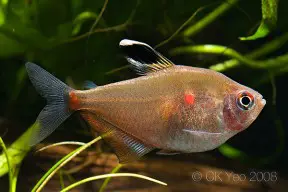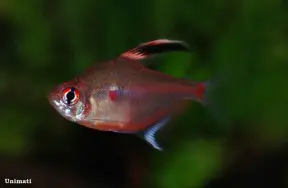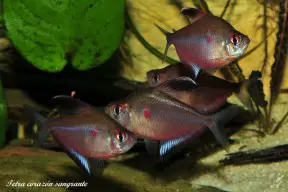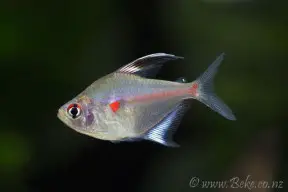Hyphessobrycon erythrostigma
Bleeding Heart Tetra
SynonymsTop ↑
Hemigrammus erythrostigma Fowler, 1943; Hyphessobrycon rubrostigma Hoedeman, 1956
Etymology
Hyphessobrycon: from the Ancient Greek υπελάσσων (hyphesson), meaning ‘of lesser stature’, and used as a prefix in this case, plus the generic name Brycon.
erythrostigma: from the Ancient Greek ἐρυθρός (eruthros), meaning ‘red’, and στίγμα (stigma) meaning ‘to brand’, in reference to the distinctive red flank marking.
Classification
Order: Characiformes Family: Characidae
Distribution
Type locality is given as ‘probably border area between Peru and Brazil’, and this species is native to the upper Amazon basin in the ‘Tres Fronteras’ region where the borders of Brazil, Peru and Colombia meet.
Its range is currently understood to extend from the rio Purus in Brazil at least as far upstream as the Nanay watershed close to Iquitos, Peru, and it also occurs in some Colombian tributaries.
Habitat
Mostly inhabits sluggish tributaries, side arms and forest lakes, and often associated with submerged woody structures such as roots, fallen branches, overhanging riparian vegetation or aquatic plants.
The water normally has a negligible dissolved mineral content, is poorly buffered and stained brown due to the gradual release of tannins and organic acids from decaying plant material.
In the igarapés Baré and Ubim, western Brazil, H. erythrostigma was collected from stretches measuring 5-7 metres in width with thick riparian and overhanging vegetation.
The substrate was mostly composed of sand and the fish displayed a preference for boundary zones between shallow and deeper water. Conductivity was measured at 14.2-62.1 mS/cm³, dissolved oxygen 0.12 to 0.40 mg/l and pH 3.8-6.4.
In Lake Ayapuá, rio Purus, Brazil, the fish were found in a white (turbid) water habitat where water temperature was 29.6ºC/85.3°F, conductivity 20 mS/cm³, dissolved oxygen 38.5%, pH 5.0-5.5 and depth approximately 1.5 metres.
Sympatric fish species included Hyphessobrycon bentosi, Hemigrammus bellottii, Paracheirodon sp. ‘n’, Nannostomus eques, N. unifasciatus, N. trifasciatus, Carnegiella strigata, Carnegiella marthae, Bunocephalus sp. and Otocinclus sp.
Maximum Standard Length
55 – 60 mm.
Aquarium SizeTop ↑
An aquarium with base dimensions of 90 ∗ 30 cm or equivalent should be the smallest considered.
Maintenance
Choice of décor is not especially critical although it tends to show better colouration when maintained in a well-furnished set-up with live plants and a dark substrate.
A natural-looking arrangement might consist of a soft, sandy substrate with wood roots and branches placed such a way that plenty of shady spots are formed.
The addition of dried leaf litter would further emphasise the biotope-style feel and with it the growth of beneficial microbe colonies as decomposition occurs. These can provide a valuable secondary food source for fry, whilst the tannins and other chemicals released by the decaying leaves will aid in simulating natural conditions. Leaves can be left in the tank to break down fully or removed and replaced every few weeks.
This species seems to do best under relatively dim lighting, and also appreciates floating vegetation.
Like many fishes that naturally inhabit pristine environments it is intolerant to accumulation of organic pollutants and requires spotless water meaning weekly water changes should be considered routine, and it should never be introduced to a biologically immature tank.
Water Conditions
Temperature: 21 – 28 °C
pH: 4.0 – 7.5
Hardness: 18 – 215 ppm
Diet
This species is an opportunistic omnivore by nature.
The stomach contents of wild specimens from Lake Ayapuá were composed of fruit remains, aquatic insects and larvae (Trichoptera, Diptera) with the former constituting 98.5 % and latter 1 % of all items consumed.
Stomachs of individuals from igarapé Ubim contained 75 % aquatic insects and larvae (Ephemeroptera: Baetidae and Diptera: Chironomidae), 20 % fragments of higher plant and 5 % aquatic plants.
In the aquarium it is easily-fed but the best condition and colours offer regular meals of small live and frozen foods such as chironomid larvae (bloodworm), Daphnia, and Artemia alongside good quality dried flakes and granules, at least some of which should include additional plant or algal content.
Submerged pieces of fresh fruit will also be grazed but should only be left in the aquarium for a few hours.
Behaviour and CompatibilityTop ↑
Generally peaceful making it an ideal resident of the well-researched community aquarium, although adult males are territorial to an extent, and this behaviour may sometimes extend to similarly-shaped species.
It is perhaps best-maintained alongside similarly-sized characids, gasteropelecids, lebiasinids, smaller callichthyid or loricariid catfishes and non-predatory, medium-sized cichlids.
Try to buy a mixed-sex group of at least 8-10 specimens, include other schooling fishes to provide security, and you’ll be rewarded with a more natural-looking spectacle.
The interaction between rival males is fascinating to watch and they will display their best colours when competing for female attention or hierarchical position.
Sexual Dimorphism
Males grow noticeably larger and are more intensely-coloured than females.
In adult males the dorsal, pelvic and anal fins are highly extended, while adult females tend to be rounder in shape, especially when gravid.
Reproduction
Egg scatterer exhibiting no parental care.
NotesTop ↑
This is the best-known of three similar-looking species most commonly-referred to as the ‘bleeding heart’ subgroup, the other two being H. socolofi and H. pyrronhotus.
All possess a reddish humeral spot which is not present in any other characid with other shared characters including possession of 6 -14 maxillary teeth, 7-9 scales above the lateral line, 5-7 scales below the lateral line and 26-33 anal fin rays.
H. erythrostigma differs from H. socolofi in the following characters: 33-34 vertebrae, mode 33 (vs. 31-33, mode 32 in H. socolofi); a white longitudinal band extending distally along the majority of the anal-fin in adults, covering 70-95 % of the rays (vs. white band covering 45-50 % of the branched anal-fin rays only); first branched ray of anal-fin longest in adult males (vs. third branched ray); presence of hook-like structures on the anal, pelvic and dorsal fins in mature males (vs. numerous hooks on all fins except the adipose -fin in mature males); absence of such hooks in females (vs. hooks present in the anal-fin of mature females); (scales cycloid (vs. scales cyclo-ctenoid in mature males and some mature females); pelvic-fin of females measuring 19.63-23.83 % SL, reaching tip of 3rd-5th branched anal-fin rays (vs. 15.69-18.88 %, reaching origin of 1st branched anal-fin ray).
It can be told apart from H. pyrrhonotus by lacking (vs. possessing) a red, wedge-shaped patch of red pigmentation in the upper part of the body and the presence (vs. absence) of hook-like structures on the anal, pelvic and dorsal fins in mature males.
Limited genetic analyses have revealed that the bleeding heart group is probably monophyletic, but that there may be more species involved (Paz et al., 2014). The current concept of H. socolofi appears to represent a paraphyletic taxon, for example, while H. pyrrhonotus also contains distinct lineages, although further work is necessary in order to deduce taxonomic implications.
In addition to forming their own putative assemblage the bleeding heart tetras have regularly been included in the larger ‘Hyphessobrycon bentosi‘ subgroup of the H. callistus group as proposed by Géry (1977). At the time of Géry’s work H. erthythrostigma was the only recognised bleeding heart tetra and he considered it to differ from other H. bentosi subgroup members by a combination of morphometric characters plus the red humeral spot.
Weitzman & Palmer (1997) expanded Géry’s concept and proposed the existence of a putatively monophyletic assemblage based on colour pattern and male fin morphology that they termed the ‘rosy tetra clade’. It was composed of species with the following shared characters which set them apart from other Hyphessobrycon species: pink to red or reddish-brown body colour; 22-29 branched anal-fin rays; 29-34 longitudinal scales; two sets of teeth on the premaxilla with 1-4 teeth in the outer series and 7-12 in the inner series.
Hyphessobrycon was raised by Durbin in Eigenmann (1908) as a subgenus of Hemigrammus, differing from the latter by the absence of scales on the caudal-fin.
The grouping was revised by Eigenmann (1918, 1921) while Géry (1977) created artificial groups of species based on colour pattern, and these definitions are still widely used today, e.g., the H. agulha group, the H. heterohabdus group, etc. These cannot be considered to represent monophyletic assemblages, however, and their concepts continue to be redefined.
Weitzman & Palmer (1997) hypothesised the existence of a monophyletic assemblage within the genus based on colour pattern and male fin morphology that they termed the ‘rosy tetra clade’, with one of the characters supporting its monophyly being presence of a prominent dark marking on the dorsal-fin. This assemblage, plus other morphologically similar species, is considered to represent Hyphessobrycon sensu stricto by some authors, with the remaining species included in a much-expanded H. heterohabdus group.
Others have proposed conflicting, typically more restricted, views of both the genus and/or its constituent species groups, and significant confusion remains. What is clear is that, as currently recognised, Hyphessobrycon is a polyphyletic lineage containing several genera.
The process of splitting it up has already started, and Malabarba et al. (2012) revalidated the genus Ectrepopterus Fowler, previously considered a synonym of Hyphessobrycon. They also analysed its relationships within the Characidae in the context of Mirande’s (2010) previous work, but included the type species, H. compressus, for the first time in such a study. The results demonstrated that H. compressus is more closely-related to ‘rosy tetra’ representatives such as H. eques, H. pulchripinnis, and H. socolofi than other members of the genus including H. anisitsi, H. bifasciatus, H. elachys, H. herbertaxelrodi, and H. luetkeni.
Like many small characids, H. erythrostigma is known to be susceptible to an affliction which causes some or all of the body scales to appear metallic gold in colour. It remains unclear whether this is a consequence of a parasitic infestation, as has been suggested, but affected fish appear to be in no discomfort and their lifespan and overall health seem undiminished.
References
- Calcagnotto, D., S. A. Schaefer, and R. DeSalle, 2005 - Molecular Phylogenetics and Evolution 36(1): 135-153
Relationships among characiform fishes inferred from analysis of nuclear and mitochondrial gene sequences. - Fowler, H. W., 1943 - The Fish Culturist 22(5): 33-34
Description of a new South American characin referred to Hemigrammus. - Géry, J., 1977 - T.F.H. Publications, Inc.: 1-672
Characoids of the World. - Hein, G., 2009 - Bulletin of Fish Biology 10(1/2): 1-10
Hyphessobrycon pando sp. n., a new rosy tetra from northern Bolivia (Teleostei, Characiformes, Characidae). - Malabarba, L. R., V. A. Bertaco, F. R. Carvalho & T. O. Litz., 2012 - Zootaxa 3204: 47-60
Revalidation of the genus Ectrepopterus Fowler (Teleostei: Characiformes), with the redescription of its type species, E. uruguayensis. - Mirande, J. M., 2010 - Neotropical Ichthyology 8(3): 385-568
Phylogeny of the family Characidae (Teleostei: Characiformes): from characters to taxonomy. - Oliveira, C. A., G. S. Avellino, K. T. Abe, T. C. Mariguela, R. C. Benine, G. Orti, R. P. Vari, and R. M. Corrêa e Castro, 2011 - BMC Evolutionary Biology 11(1): 275-300
Phylogenetic relationships within the speciose family Characidae (Teleostei: Ostariophysi: Characiformes) based on multilocus analysis and extensive ingroup sampling. - Paz, F. P. C., J. D. S. Batista, and J. I. R. Porto, 2014 - PLoS One 9(5): e98603
DNA Barcodes of Rosy Tetras and Allied Species (Characiformes: Characidae: Hyphessobrycon) from the Brazilian Amazon Basin. - Reis, R. E., S. O. Kullander and C. J. Ferraris, Jr. (eds), 2003 - EDIPUCRS, Porto Alegre: i-xi + 1-729
Check list of the freshwater fishes of South and Central America. CLOFFSCA. - Weitzman, S. H. and L. Palmer, 1997 - Ichthyological Exploration of Freshwaters 7(3): 209-242
A new species of Hyphessobrycon (Teleostei: Characidae) from the Neblina region of Venezuela and Brazil, with comments on the putative `rosy tetra clade'. - Zarske, A., 2014 - Vertebrate Zoology 64(2): 139-167
Zur Systematik einiger Blutsalmler oder "Rosy Tetras" (Teleostei: Ostariophysi: Characidae).

